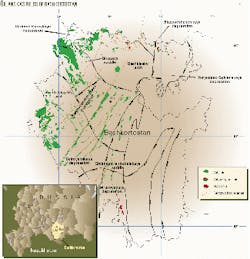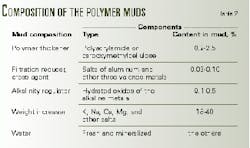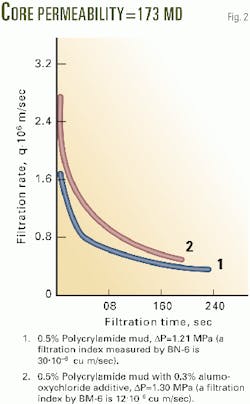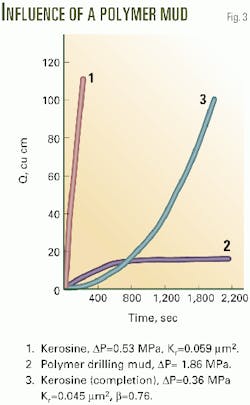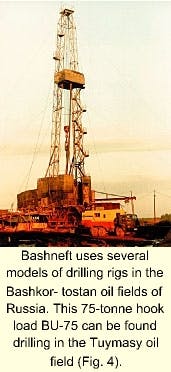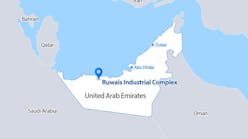Polymer-based drilling fluids used in the Bashkortostan fields of Russia can increase penetration rates, improve core recovery, minimize formation damage, retain a near-gauge hole, and reduce transportation and preparation costs.
Additionally, polymer muds maintain optimal filtrate cake properties and serve as a tool for bed segregation and selective isolation of water-bearing formations.
Bashkirian drillers have additionally found advantages in drilling single and cluster wells with this type of drilling fluid. In the first 3 years, polymer-based muds helped drill 310 development wells, with steady improvements in drilling efficiencies over clay-based muds (Table 1).
Advantages
A drilling mud must maintain the natural permeability of the reservoirs throughout the drilling process by minimizing fluid invasion into the porous space of a reservoir.
New developments that minimize reservoir damage in the pay zones include:
- Use of polymer drilling muds without a solid phase (no clay). This fluid contains base chemicals polyacrylamide and carboxylmethylcellulose and salts with multivalence metals.
- Application of downhole motors (turbodrill, positive displacement motors) instead of the rotary drilling method.
- Reduction in drilling fluid density.
These processes increased the technical and economical drilling indices as well as the quality of the carbonate and terrigenous reservoirs in a section known for low or normal formation pressure gradients.
Applications
In the fields of Bashkortostan (Fig. 1), drillers circulate the surface hole section with clayless polymer drilling muds. After drilling this section, crewmembers then dilute the drilling mud with water while allowing polymer concentrations to drop to 0.005-0.010%.
As drilling continues through the intermediate hole section, crewmembers apply solids-removal procedures aided by dilution with water.
Then once in the reservoir section, the operator again flushes the system and begins drilling with a polymer-based drilling mud without a solid phase. During this phase, cuttings are flocculated throughout the section.
Polymer variations
There are different recipes readily available for polymer, polymer-salt, and polymer-emulsion drilling muds that can be formulated from acryl polymers or derivatives of starch, biopolymers, and polyethyleneoxide where the advantage of one formulation over another is related to the chemical structure of the polymers.
Procedures for analyzing spatial structure in a polymer water solution can be accomplished by introducing specific complex formers such as polyvalence metal salts.
Through such additions, polymer, polymer-salt, polymer-low-clay, and asbo-salt-gel drilling muds with high colmatation abilities have been developed. Medium-fresh, mineralized, or formation waters are used as a dispersant.
The dispersing phase of these muds can be synthesized in a solution or introduced in a form of variously dispersed particles. Technicians found that the synergetic effect of dynamic viscosity increases through the interaction of acryl polymers and carboxymethylcellulose.
Formulation
Polymer muds contain isolated features that depend on the dynamic viscosity of the muds, the regimen and duration of filtration, and the permeable nature of the rocks. During the filtration process, an initial gradient appears, then pore-medium colmatation and clogging develops, and finally a filter cake forms.
It has been proposed that as polymer-mud filtration forms formulates through polymer adsorption, fractionation of the macromolecules within the porous media takes place. As a result of pore clogging, a reduction in the coefficient of permeability occurs and generates additional filtration resistance.
During the drilling and completion processes, Bashkirian drillers use two types of polymer muds: high-viscosity colloid polymer muds without a dispersing phase and polymer muds with a polymer-salt dispersant (cross polymers).
These muds are called polymer-salts or polymer-dispersants, respectively. The bases for both mud types contain water-soluble polymer thickeners: polyacrylamide (PAA), and carboxymethylcellulose (CMC).
The first mud type consists of high-viscosity colloidal polyacrylamide solutions (0.2-0.5% concentration). These muds, which have low mud densities of 1.0-1.01 kg/cu m, inadequately drill formations with high pore-pressure gradients. Increased mud weight may be achieved by introducing salts of sodium, potassium, calcium, and other metals into the mud as well as dissolving a polymer in mineralized formation water.
Introduction of salt additives and dissolution in mineralized formation water reduces the polymer mud viscosity. To provide the required viscosity, it becomes necessary, in individual cases, to increase the polymer concentration in the drilling fluid up to 0.6-1.2%. This mud type is recommended for pay zones with less than 51 md of permeability.
The polymer dispersant mud also contains a polymer-salt dispersing phase in the form of nonwater soluble micro-gels consisting of different shapes and sizes. Additionally, this mud type can contain a widely spaced-crossed polymer.
To obtain a polymer dispersant, it is necessary to introduce small amounts (0.03-0.10%) of aluminum salts or other three-valence metals (ferrum or chromium) to the polymer salt-based mud.
At this point, the ions of the three-valence metals, which form the crossing agent between the polymer molecules, leads to the formation of a polymer-salt dispersing phase. Through the addition of chlorous and oxi-chlorous salts of the three-valence metal group, the accompanying anions do not form solid sediments with calcium and magnesium cations.
When a sulfide ion, which is contained in the filtrate, enters a porous medium, it interacts with the calcium ions of residual water and forms a gypsum sediment. At this point the pores clog, the rock permeability decreases, and it becomes extremely difficult to remove the damage.
Indices
To eliminate formation pore clogging with gypsum, it is possible, however, to precipitate the sulfide ions with calcium chloride in an equimolecular relationship. In such cases, aluminum chloride salts remain in the mud.
Table 2 shows the following compositions of polymer muds that have been developed where the quantity of ingredients in the mud depends on a polymer quality, geologic, technical, and hydrological conditions of the well.
Technicians define the polymer mud property indices according to standard methods, defined by the following parameters:
- Density = 1,000-1,350 kg/cu m.
- Specific viscosity = 18-50 cps.
- Filtration index = 4-10 cu cm/0.4 hr.
- pH = 6-9.
Using the regulated methods of the polymer drilling mud property indices according to the type of additive, one can obtain hundreds of formulations that meet reservoir drilling requirements.
Tests
To estimate the polymer mud filtration and isolation properties, technicians conducted filtration tests of natural oil-saturated cores with different permeabilities using an UIPK-1M unit. For this work, domestic muds and foreign polymers of different brands were used such as CS-6, Sedipur, Polydia, and DK Drill.
The tests showed that polymer mud filtration decreased quickly (Fig. 2). The polymer muds reduced the permeability of water-saturated rocks to a higher degree (>10%) than oil-saturated rocks (<10%). The isolation coefficient, defined as a ratio of core permeability (after polymer mud filtration) to initial permeability, achieved values of 99.0-99.8%.
For a given filtration period, only an insufficient quantity of a polymer mud filtrate can penetrate the reservoir. A coefficient of oil-saturated rock permeability recovery (after filtration of the polymer muds) was tested at 76% as compared to the initial sample (Fig. 3); in a case of clay mud, however, it did not exceed 50%.
Correspondingly, as these polymer muds contaminated the formation to a lesser degree than other options, they became the drilling fluid of choice for drilling operations in Bashkortostan.
Technology influence
Technology influence
To evaluate the influence of drilling mud types in the reservoir, drilling personnel conducted a series of tests. While drilling these pilot wells (Fig. 4), technicians perfected the preparation techniques and the chemical makeup of the polymer mud and found early on that this fluid did not negatively affect the reservoir.
The results (Table 3) showed that rotary drilling with polymer-based mud increased bit life and penetration rates while reducing drilling cycle time two-fold throughout the reservoir. This did not adequately reduce rig time and expenditures as penetration rates remained inadequate.
Moreover, the drillers found that downhole motors used with clay-based mud induced high hydraulic resistance and skin damage.
In comparison, the polymer fluids, with the absence of a solid phase, provided good lubricating properties and low relative viscosities and densities at satisfactory values according. As a result, a number of wells in the productive zones were drilled with turbodrills instead of the rotary table.
This technology increased penetration rates almost six-fold and reduced the penetration time throughout the productive zones from 50 to 8 hr. As a matter of course, the total time of polymer interaction with the productive formations declined.
Turbodrills
As Table 3 shows, reservoir intervals drilled with a combination of polymer muds and turbodrills increased overall penetration rates. On average, total penetration time in the productive interval and expenditures spent on wellbore washing fell 15-20% and 10%, respectively.
Additionally, downtime was eliminated or reduced. Penetration rates/well were increased by 25%. Costs for materials, chemicals, transportation, preparation, and processing were reduced as well. And due to the absence of a solid phase in the polymer drilling mud, aided by effective lubricating properties, the time period between motor overhauls increased.
After replacement of clay mud with polymer, the quality of side-wall core sampling in a terrigenous section improved with the use of wireline drill-and-disc prismatic core samplers. Finally, drillers have noted no troubles related to well logging and production string cement operations.
The author
Konstantin Vassilievich Antonov is the chief of department-Bashkortostan Government for Geology and Subsoil Utilization (BGGSU). Before joining BGGSU, he worked as a geologist for Bashneft Co. and Neftekamsk Drilling Co. He holds a candidate of technical science from the Ufa Oil Institute (1993) and has been a corresponding member of the Russia Natural Science Academy since 1997. Antonov is a member of the International Information Academy, European & Asian Geophysical Society, and Russian Association of Oil & Gas Geologists.

